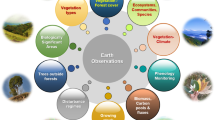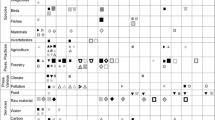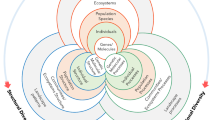Abstract
The strong contribution of remote sensing has led to the development of the concept of the Remote Sensing enabled Essential Biodiversity Variables which represents a set of variables that can be monitored from space. This work synthesizes current state of research and technological development in use of remote sensing enabled essential biodiversity variables. The issue of scale, satellite observation requirements and status of remote sensing have been discussed in the context of monitoring of community composition, plant functional types, vegetation structure, canopy diversity, targeted animal groups, fragmentation, disturbances and as an input for biodiversity modelling, and Earth Observations based variables. This work highlighted existing approaches for addressing community level biodiversity and discusses in the context of Earth Observations as which are key components for biodiversity monitoring strategy. Biodiversity monitoring could be improved by using new satellite sensors and the synergy of remotely sensed data from multiple sensors which are providing hyperspatial, hyperspectral and hypertemporal observations. The use of remote sensing for operational monitoring of biodiversity is still under development as existing approaches and techniques have not holistically addressed the metrics of essential biodiversity variables.


Similar content being viewed by others
References
Adamo M et al (2014) Expert knowledge for translating land cover/use maps to General Habitat Categories (GHC). Landscape Ecol 29(6):1045–1067
Araya S, Ostendorf B, Lyle G, Lewis M (2018) CropPhenology: An R package for extracting crop phenology from time series remotely sensed vegetation index imagery. Ecological Informatics 46:45–56
Bergen K, Goetz S, Dubayah R, Henebry G, Hunsaker C, Imhoff M, Nelson R, Parker G, Radeloff V (2009) Remote sensing of vegetation 3-D structure for biodiversity and habitat: Review and implications for Lidar and Radar spaceborne missions. J Geophysical Research. https://doi.org/10.1029/2008JG000883
Boyd DS, Danson FM (2005) Satellite remote sensing of forest resources: three decades of research development. Prog Phys Geogr 29(1):1–26
Clark ML, Roberts DA (2012) Species-level differences in hyperspectral metrics among tropical rainforest trees as determined by a tree-based classifier. Remote Sensing 4:1820–1855
Couteron P, Barbier N, Gautier D (2006) Textural ordination based on Fourier spectral decomposition: A method to analyze and compare landscape patterns. Landscape Ecol 21:555–567
Duro DC, Coops NC, Wulder MA, Han T (2007) Development of a large area biodiversity monitoring system driven by remote sensing. Progress in Phyical Geography 31:235–260
Feng X, Fu B, Yang X, Lü Y (2010) Remote sensing of ecosystem services: An opportunity for spatially explicit assessment. Chin Geogra Sci 20(6):522–535
Feret J-B, Asner GP (2014) Mapping tropical forest canopy diversity using high-fidelity imaging spectroscopy. Ecol Appl 24:1289–1296
Fernández N (2013) Earth observation for species diversity assessment and monitoring. In: Alcaraz-Segura DB, Straschnoy (eds) Earth observation of ecosystem services. CRC Press Taylor & Francis Group, Boca Raton, pp 151–177
Gitay H, Noble I (1997) What are functional types and how should we seek them. In: Smith TM, Shugart HH, Woodward FI (eds) Plant functional types: their relevance to ecosystem properties and global change vol 1. Cambridge University Press, Cambridge., pp 3–19
GOFC-GOLD (2017). A Sourcebook of Methods and Procedures for Monitoring Essential Biodiversity Variables in Tropical Forests with Remote Sensing. Eds: GOFC-GOLD & GEO BON. Report version UNCBD COP-13, GOFC-GOLD Land Cover Project Office, Wageningen University, The Netherlands.
Goodwin N, Turner R, Merton R (2005) Classifying eucalyptus forests with high spatial and spectral resolution imagery: an investigation of individual species and vegetation communities. Aust J Bot 53:337–345
Groom G, Stjernholm M, Nielsen RD, Fleetwood A, Petersen IK (2013) Remote Sensing Image Data and Automated Analysis to Describe Marine Bird Distributions and Abundances. Ecological Informatics 14:2–8. https://doi.org/10.1016/j.ecoinf.2012.12.001
Hazen H (2009) Biodiversity Mapping International Encyclopedia of Human Geography. Elsevier, Amsterdam The Netherlands, pp 314–319
Hernández-Stefanoni JL, Dupuy JM, Johnson KD, Birdsey R, Tun-Dzul F, Peduzzi A, Caamal-Sosa JP, Sánchez-Santos G, López-Merl’ D (2014) Improving species diversity and biomass estimates of tropical dry forests using airborne LiDAR. Remote Sensing 6:4741–4763
Higgins MA, Asner GP, Perez E, Elespuru N, Tuomisto H, Ruokolainen K, Alonso A (2012) Use of Landsat and SRTM data to detect broad-scale biodiversity patterns in Northwestern Amazonia. Remote Sensing 4:2401–2418
Hirschmugl M, Ofner M, Raggam J, Schardt M (2007) Single tree detection in very high resolution remote sensing data. Remote Sens Environ 110(4):533–544
Immitzer M, Atzberger C, Koukal T (2012) Tree species classification with random forest using very high spatial resolution 8-band WorldView-2 satellite data. Remote Sensing 4:2661–2693
Immitzer M, Vuolo F, Atzberger C (2016) First experience with sentinel-2 data for crop and tree species classifications in Central Europe. Remote Sensing 8:166
Jha CS, Rakesh SJ, Reddy CS, Rajashekar G, Maity S, Patnaik C, Das A, Misra A, Singh CP, Mohapatra J, Krishnayya NSR, Kiran S, Townsend P, Martinez M (2019) Characterization of species diversity and forest health using AVIRIS-NG hyperspectral remote sensing data. Curr Sci 116(7):1124–1135
Kim M, Madden M, Warner TA (2009) Forest type mapping using object-specific texture measures from multispectral Ikonos imagery. Photogrammetric Engineering & Remote Sensing 75:819–829
Kuenzer C, Ottinger M, Wegmann M, Guo H, Wang C, Zhang J, Dech S, Wikelski M (2014) Earth observation satellite sensors for biodiversity monitoring: potentials and bottlenecks. Int J Remote Sens 35:6599–6647
Lang S, Mairota P, Pernkopf L, Schioppa EP (2015) Earth observation for habitat mapping and biodiversity monitoring. Int J Appl Earth Obs Geoinf 37:1–6
Laurin GV, Puletti N, Hawthorne W, Liesenberg V, Corona P, Papale D, Chen Q, Valentini R (2016) Discrimination of tropical forest types, dominant species, and mapping of functional guilds by hyperspectral and simulated multispectral Sentinel-2 data. Remote Sens Environ 176:163–176
Lausch A et al (2016) Linking Earth Observation and taxonomic, structural and functional biodiversity: Local to ecosystem perspectives. Ecol Ind 70:317–339
Leutner BF, Reineking B, Müller J, Bachmann M, Beierkuhnlein C, Dech S, Wegmann M (2012) Modelling forest alpha-diversity and floristic composition - On the added value of LiDAR plus hyperspectral remote sensing. Remote Sensing 4:2818–2845
Leyequien E, Verrelst J, Slot M, Schaepman-Strub G, Heitkönig IMA, Skidmore A (2007) Capturing the Fugitive: Applying Remote Sensing to Terrestrial Animal Distribution and Diversity. Int J Appl Earth Obs Geoinf 9(1):1–20. https://doi.org/10.1016/j.jag.2006.08.002
Levin SA (1992) The problem of pattern and scale in ecology: the Robert H. MacArthur award lecture Ecology 73:1943–1967
Li X, He HS, Bu R, Wen Q, Chang YHu, Y & Li, Y (2005) The adequacy of different landscape metrics for various landscape patterns. Pattern Recogn 38:2626–2638
Liu H, Dong P (2014) A new method for generating canopy height models from discrete-return LiDAR point clouds. Remote Sensing Letters 5(6):575–582
Loozen Y, Rebel KT, de Jong SM, Lu M, Ollinger SV, Wassen MJ, Karssenberg D (2020) Mapping canopy nitrogen in European forests using remote sensing and environmental variables with the random forests method. Remote Sens Environ 247:111933
Mairota P, Cafarelli B, Labadessa R, Lovergine F, Tarantino C, Lucas RM, Didham RK (2015) Very high resolution Earth observation features for monitoring plant and animal community structure across multiple spatial scales in protected areas. Int J Appl Earth Obs Geoinf 37:100–105
McGarigal K, Cushman S, Regan C (2005) Quantifying terrestrial habitat loss and fragmentation: a protocol. University of Massachusetts, Department of Natural Resources Conservation, Amherst, MA, p 113
McMahon CR, Howe H, van den Hoff J, Alderman R, Brolsma H et al (2014) Satellites, the All-Seeing Eyes in the Sky: Counting Elephant Seals from Space. PLoS ONE 9(3):e92613. https://doi.org/10.1371/journal.pone.0092613
Mendenhall CD, Shields-Estrada A, Krishnaswami AJ, Daily GC (2016) Quantifying and sustaining biodiversity in tropical agricultural landscapes. Proc Natl Acad Sci USA 113:14544–14551
Nagendra H (2001) Using remote sensing to assess biodiversity. Int J Remote Sens 22:2377–2400
Noss RF (1990) Indicators for monitoring biodiversity: a hierarchical approach. Conserv Biol 4:355–364
O’Neill RV, King AW (1998) Homage to St.Michael: Or why are there so many books on scale?" in Ecological Scale, Theory and Applications. In: Peterson DL, Parker VT (eds) Ecological scale: theory and applications. Columbia University Press, New York, pp 3–15
Paganini M, Leidner AK, Geller G, Turner W, Wegmann M (2016) The role of space agencies in remotely sensed essential biodiversity variables. Remote Sensing in Ecology and Conservation 2(3):132–140
Pereira HM et al (2013) Essential biodiversity variables. Science 339(6117):277–278
Pettorelli N et al (2016) Framing the concept of satellite remote sensing essential biodiversity variables: challenges and future directions. Remote Sensing in Ecology and Conservation 2(3):122–131
Pontius J, Schaberg P, Hanavan R (2020) Remote Sensing for Early, Detailed, and Accurate Detection of Forest Disturbance and Decline for Protection of Biodiversity. In: Cavender-Bares J, Gamon J, Townsend P (eds) Remote Sensing of Plant Biodiversity. Springer, Cham, pp 121–154
Proisy C, Barbier N, Guéroult M, Pélissier R, Gastellu-Etchegorry JP, Grau E, Couteron P (2012) Biomass prediction in tropical forests: the canopy grain approach. In: Fatoyinbo L (ed) Remote Sensing of Biomass-Principles and Applications. IntechOpen, London, pp 59–76
Radeloff VC, Dubinin M, Coops NC, Allen AM, Brooks TM, Clayton MK, Costa GC, Graham CH, Helmers DP, Ives AR, Kolesov D et al (2019) The dynamic habitat indices (DHIs) from MODIS and global biodiversity. Remote Sens Environ 222:204–214
Reddy CS, Khuroo AA, Harikrishna P, Saranya KRL, Jha CS, Dadhwal VK (2014) Threat evaluation for biodiversity conservation of forest ecosystems using geospatial techniques: A case study of Odisha, India. Ecol Eng 69:287–303
Reddy CS, Saranya KRL, Pasha SV, Satish KV, Jha CS, Diwakar PG, Dadhwal VK, Rao PVN, Krishna Murthy YVN (2018) Assessment and monitoring of deforestation and forest fragmentation in South Asia since the 1930s. Global Planet Change 161:132–148
Rocchini D, Boyd DS, Féret JB, Foody GM, He KS, Lausch A, Pettorelli N (2016) Satellite remote sensing to monitor species diversity: Potential and pitfalls. Remote Sensing in Ecology and Conservation 2(1):25–36
Rodriguez JP et al (2011) Establishing IUCN red list criteria for threatened ecosystems. Conserv Biol 25:21–29
Roy PS, Kushwaha SPS, Murthy MSR, Roy A, Kushwaha D, Reddy CS, Behera MD, Padalia H, Mathur VB, Singh S, Jha CS, Porwal MC (2012) Biodiversity Characterisation at Landscape Level: National Assessment. Indian Institute of Remote Sensing, Dehra Dun
Secades, C., O'Connor, B., Brown, C., Walpole, M. (2014). Earth Observation for Biodiversity Monitoring: A review of current approaches and future opportunities for tracking progress towards the Aichi Biodiversity Targets. Secretariat of the Convention on Biological Diversity, Montréal, Canada. Technical Series No. 72, 183 pages.
Singh H, Garg RD, Karnataka HC, Roy A (2018) Spatial landscape model to characterize biological diversity using R statistical computing environment. J Environ Manag 206:1211–1223
Skidmore A et al (2015) Environmental science: Agree on biodiversity metrics to track from space. Nature 523:403–405
Stoms DM, Estes JE (1993) A remote sensing research agenda for mapping and monitoring biodiversity. Int J Remote Sens 14(10):1839–1860
Tarr NM (2019) Demonstrating a conceptual model for multispecies landscape pattern indices in landscape conservation. Landscape Ecol 34(9):2133–2147
Turner MG, Dale VH, Gardner RH (1989) Predicting across scales: theory development and testing. Landscape Ecol 3:245–252
Turner MG, Gardner RH, O’Neill RV (2001) Landscape Ecology in Theory and Practice. Springer, New York
Turner W, Spector S, Gardiner N, Fladeland M, Sterling E, Steininger M (2003) Remote sensing for biodiversity science and conservation. Trends Ecol Evol 18:306–314
Underwood EC, Ustin SL, Ramirez CM (2007) A comparison of spatial and spectral image resolution for mapping invasive plants in coastal California. Environ Manage 39:63–83
USNVC. (2017). United States National Vegetation Classification Database, V2.01. Federal Geographic Data Committee, Vegetation Subcommittee, Washington DC. (usnvc.org).
Ustin SL, Gamon JA (2010) Remote sensing of plant functional types. New Phytol 186:795–816
Van der Maarel, E. & Franklin, J. (2012). Vegetation ecology. John Wiley & Sons. Indicative definitions taken from the Report of the ad hoc technical expert group on forest biological diversity. ps://www.cbd.int/forest/definitions.shtml.
Vierling KT, Vierling LA, Gould WA, Martinuzzi S, Clawges RM (2008) Lidar: shedding new light on habitat characterization and modeling. Front Ecol Environ 6:90–98
Wang R, Gamon JA (2019) Remote sensing of terrestrial plant biodiversity. Remote Sens Environ 231:111218
Wang K, Franklin SE, Guo X, Cattet M (2010) Remote sensing of ecology, biodiversity and conservation: a review from the perspective of remote sensing specialists. Sensors 10(11):9647–9667
Wilson EO (ed) (1988) Biodiversity. National Academy Press, Washington DC
Wessel M, Brandmeier M, Tiede D (2018) Evaluation of different machine learning algorithms for scalable classification of tree types and tree species based on Sentinel-2 data. Remote Sensing 10(9):1419
Westman WE, Strong LL, Wilcox BA (1989) Tropical deforestation and species endangerment: the role of remote sensing. Landscape Ecol 3(2):97–109
Wu J, Li H (2006) Concepts of scale and scaling. In: WU J, JONES KB, LI H, LOUCKS OL (Eds), Scaling and Uncertainty Analysis in Ecology. Springer, Dordrecht
Wulder MA, Hall RJ, Coops NC, Franklin SE (2004) High spatial resolution remotely sensed data for ecosystem characterization. Bioscience 54(6):511–521
Zhang Z, Cao L, She G (2017) Estimating Forest Structural Parameters Using Canopy Metrics Derived from Airborne LiDAR Data in Subtropical Forests. Remote Sensing 9(9):940
Acknowledgements
This work has been carried out as part of a project on Biodiversity Characterisation at Community level in India using Earth Observation Data. We gratefully acknowledge the Department of Biotechnology and the Department of Space, Government of India for supporting this research. We are grateful to Director, NRSC, Hyderabad, Director, IIRS, Dehradun and Director, French Institute of Pondicherry for providing all necessary support to carry out the study.
Author information
Authors and Affiliations
Corresponding author
Additional information
Communicated by Neil Brummitt.
Publisher's Note
Springer Nature remains neutral with regard to jurisdictional claims in published maps and institutional affiliations.
Rights and permissions
About this article
Cite this article
Reddy, C.S., Kurian, A., Srivastava, G. et al. Remote sensing enabled essential biodiversity variables for biodiversity assessment and monitoring: technological advancement and potentials. Biodivers Conserv 30, 1–14 (2021). https://doi.org/10.1007/s10531-020-02073-8
Received:
Revised:
Accepted:
Published:
Issue Date:
DOI: https://doi.org/10.1007/s10531-020-02073-8




